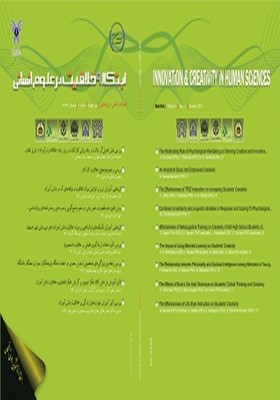-
-
List of Articles
-
Open Access Article
1 - The Moderating Role of Psychological Well-Being on Showing Creative and Innovative Behavior through the Suggestion System
Alireza Khorakian Yaghoob Maharati Mohammad Rasoul Heshmati -
Open Access Article
2 - An Analytical Study into Employees Creativity
Mansour Sadeqi Mal Amiri -
Open Access Article
3 - The Effectiveness of TRIZ Instruction on Increasing Students’ Creativity
Faezeh Jahan Farahnaz Kiyanersi Ali Mohammad Rezaei -
Open Access Article
4 - Combined Uncertainty and Linguistic Variables in Response and Scoring To Psychological Questionnaires (Case Study: Abedi Creativity Questionnaire)
Shohreh Ghorbanshiroudi -
Open Access Article
5 - Effectiveness of Metacognitive Training on Creativity of Girl High School Students of Isfahan city
Ezzatolah Qadam Pour Saiedeh Sabzian Javad Assadollahi Houshang Gravand -
Open Access Article
6 - The Impact of Using Blended Learning on Students’ Creativity
Seyyed Kazem Banihashem Jesus Rezaei Mehdi Badali Ali Dana -
Open Access Article
7 - The Relationship between Personality and Spiritual Intelligence among Members of Young Researchers and Elite Club, Islamic Azad University
Parviz Mirzakhni Ali Delavar Behnam Makvandi -
Open Access Article
8 - The Effects of Bono’s Six Hats Technique on Students’ Critical Thinking and Creativity
Eskandar Fat’hi Azar Rahim Badri Gargari Ghafour Ahrari -
Open Access Article
9 - The Effectiveness of Life Style Instruction on Students’ Creativity
Mosa Bandak Hasan Maleki Abbas Abbaspour Soghra Ebrahimi Ghavam
-
The rights to this website are owned by the Raimag Press Management System.
Copyright © 2021-2025







